Liberty Bundle
Can Liberty Energy Power Up Its Future?
Founded in 2011, Liberty Energy has quickly become a key player in North American energy services. From its beginnings in hydraulic fracturing, the company has strategically expanded, setting the stage for significant growth. But what's next for Liberty Company, and how will it navigate the evolving energy landscape?
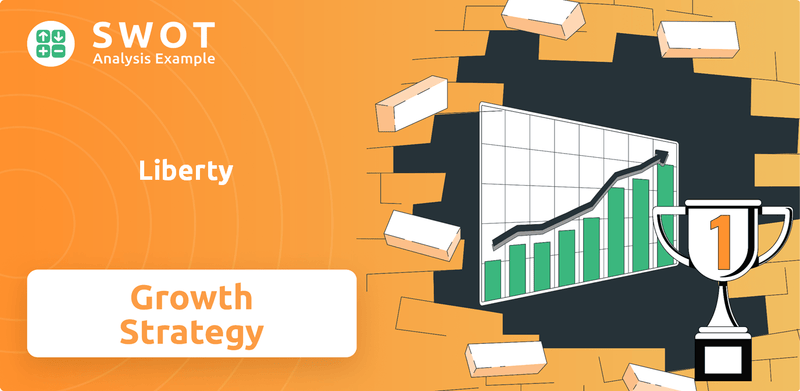
This article delves into Liberty Energy's Liberty SWOT Analysis, exploring its ambitious growth strategy and future prospects. We'll examine its recent diversification into power generation through strategic planning and business development, alongside a detailed market analysis. Discover how Liberty Company aims to capitalize on emerging opportunities and overcome potential challenges to achieve its strategic goals and objectives, providing insights into the future of Liberty Company stock and potential investment opportunities.
How Is Liberty Expanding Its Reach?
The Owners & Shareholders of Liberty are keenly focused on expansion initiatives to drive future growth. These strategies encompass both entering new markets and diversifying service offerings. The company's approach is designed to capitalize on emerging opportunities and strengthen its market position. This strategic focus is crucial for long-term value creation.
A key element of the growth strategy involves geographical expansion. In 2024, the company launched operations outside North America, specifically entering Australia's Beetaloo Basin. This move allows the company to leverage its expertise in a new, high-potential natural gas-producing field. This international expansion is a significant step in diversifying its revenue streams.
Domestically, the company is shifting its focus to significantly expand its power generation services business. This strategic move goes beyond its traditional oilfield services. The company is aiming to capitalize on the increasing demand for scalable and flexible power solutions, especially in the data center and industrial electrification sectors. This diversification is a key component of the company's business development plans.
The company expanded its operations internationally in 2024, entering the Australian market within the Beetaloo Basin. This expansion leverages the company's expertise in a new, high-potential natural gas-producing field. This strategic move is designed to diversify revenue streams and tap into new market opportunities.
The company is significantly expanding its power generation services business. This includes launching a power generation business for non-frac opportunities in 2025. The acquisition of IMG Energy Solutions in Q1 2025 enhances its capabilities in power plant EPC management and PJM utility market expertise. This will enable entry into high-growth markets.
The company plans to bring an additional 400 MW of power generation online by the end of 2026. This expansion builds upon the 130 MW already deployed, primarily supporting its digiFleet operations. This growth in distributed power systems aims to meet the increasing demand for scalable and flexible power solutions.
The company is continuously optimizing its core completions business. While maintaining a roughly flat deployed fleet count, the company plans to temporarily reduce its fleet count. Strategic investment is shifting towards power generation services. This strategic shift reflects a focus on high-growth areas.
The company's expansion strategy includes international market entry, diversification into power generation, and optimization of its core business. These initiatives are designed to drive long-term growth and enhance shareholder value. The company is actively pursuing these plans to capitalize on market opportunities.
- International expansion into the Australian market.
- Expansion of power generation services, including the acquisition of IMG Energy Solutions.
- Targeting an additional 400 MW of power generation capacity by the end of 2026.
- Strategic shift in investment towards power generation services.
Liberty SWOT Analysis
- Complete SWOT Breakdown
- Fully Customizable
- Editable in Excel & Word
- Professional Formatting
- Investor-Ready Format
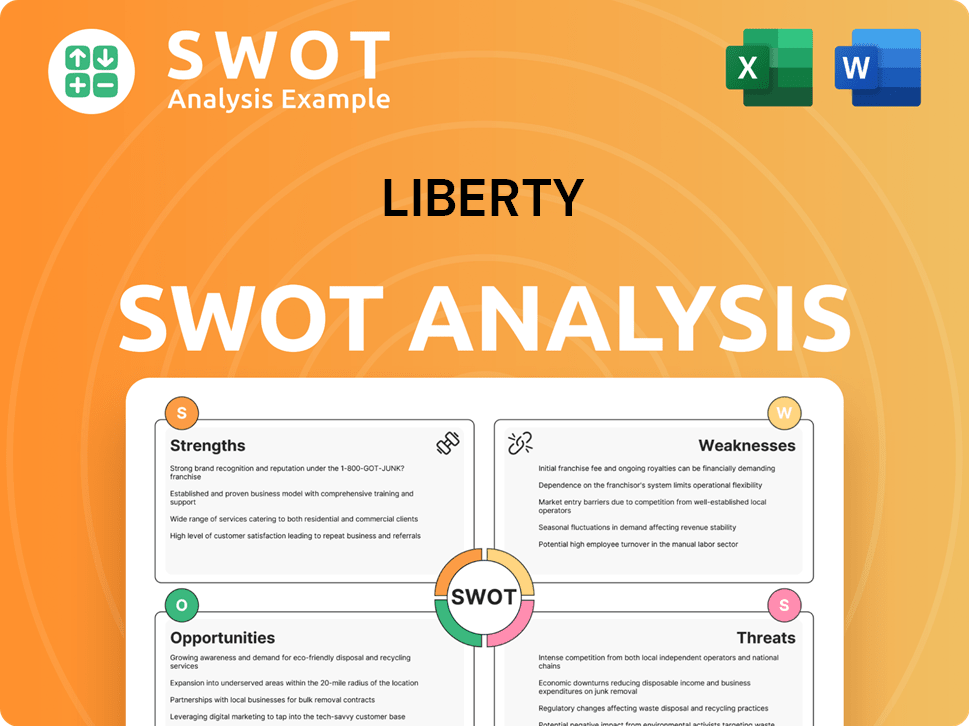
How Does Liberty Invest in Innovation?
The company's growth strategy is heavily reliant on technological innovation to enhance efficiency, reduce emissions, and improve operational performance. This focus is crucial for maintaining a competitive edge in the energy sector, especially as the industry moves towards more sustainable practices. The strategic deployment of advanced technologies is central to their future prospects.
A key element of their approach is the transition to natural gas-powered fleets, aiming for 90% utilization by early 2025. This initiative not only aligns with environmental goals but also contributes to cost savings. The adoption of digital solutions and advanced equipment further supports this strategy, driving both operational improvements and financial benefits. The company's commitment to innovation is evident in its continuous efforts to refine existing technologies and develop new ones.
The company's commitment to innovation and technology is a core part of its business development and strategic planning. Their approach to market analysis and future revenue projections is heavily influenced by these technological advancements. This focus is crucial for sustained growth and achieving their strategic goals and objectives.
The company is transitioning its fleets to natural gas, with a goal of 90% utilization by early 2025. This shift is designed to reduce emissions and lower fuel costs. This initiative is a key component of their long-term growth strategy.
Deployments of digiFleet technologies, including digiFrac and digiPrime pumps, have been accelerated. The digiPrime fleet achieved record pump efficiency over a one-year period. This demonstrates the company's commitment to innovation and its impact on market share analysis.
The latest digiPrime platform, developed with Cummins, features the industry's first natural gas variable-speed large displacement engine. This technology is set for deployment in the first half of 2025, optimizing fuel efficiency. It is a key example of how to develop a growth strategy for a company.
An integrated digital ecosystem spans pump control, power generation, fuel management, predictive maintenance, and logistics. This system enhances performance and reduces costs. This ecosystem supports Liberty's expansion plans.
The cloud-based data collection system, StimCommander, provides real-time diagnostics to increase gas substitution. This technology is crucial for analyzing the company's financial performance. It is a key element of their competitive advantage.
AI-driven predictive maintenance systems set new benchmarks in critical equipment component longevity. This technology helps streamline operations and improve asset utilization. It is a key component of Liberty's strategic goals and objectives.
The company's innovation strategy includes key patents and breakthroughs. This includes wet sand handling technology and the launch of Liberty Advanced Equipment Technologies (LAET).
- Wet Sand Handling Technology: Eliminates the need to dry sand, enabling mobile mine deployment closer to well sites.
- LAET: Allows control over the entire process from engineering to final assembly, accelerating innovation and improving delivery schedules.
- Sentinel: AI-powered logistics platform expanded to the LPI CNG delivery division in 2024, improving efficiency.
- The company's innovation efforts are a key part of their Marketing Strategy of Liberty.
Liberty PESTLE Analysis
- Covers All 6 PESTLE Categories
- No Research Needed – Save Hours of Work
- Built by Experts, Trusted by Consultants
- Instant Download, Ready to Use
- 100% Editable, Fully Customizable
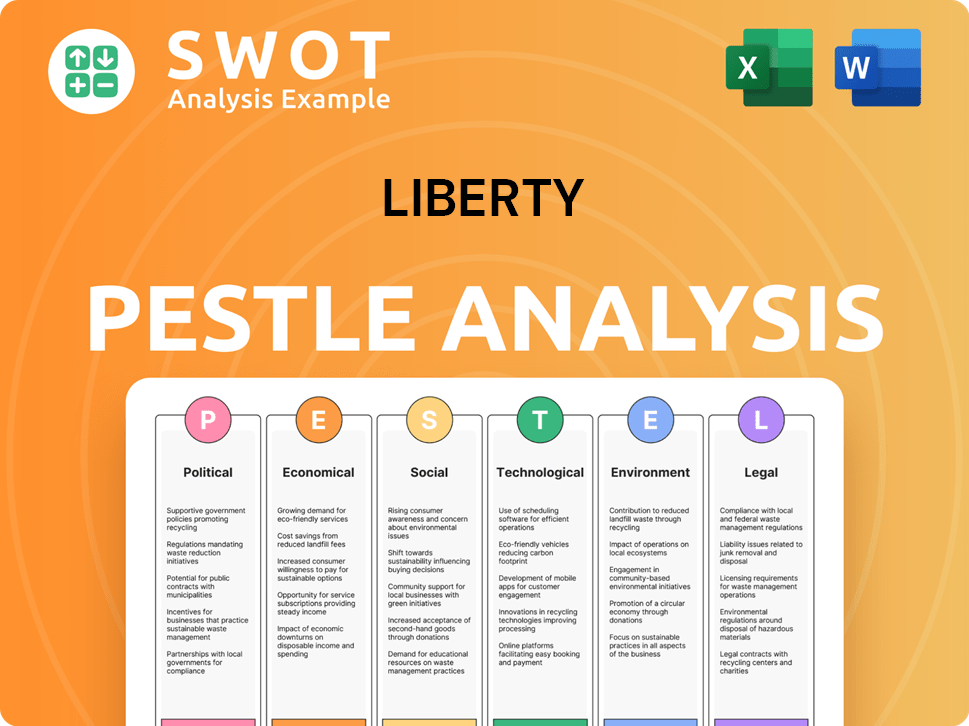
What Is Liberty’s Growth Forecast?
The financial outlook for Liberty Energy is shaped by strategic investments and a focus on generating strong free cash flow. This approach supports the company's growth strategy and long-term value creation. The company's performance in 2024 and its projections for 2025 highlight its commitment to sustainable financial health.
Liberty Energy's financial strategy includes a focus on shareholder returns and maintaining a strong balance sheet. The company is actively deploying capital expenditures to support its growth initiatives. These initiatives include investments in completions and power generation to drive future revenue and profitability.
In 2024, Liberty Energy reported revenues of $4.3 billion, a decrease from $4.7 billion in 2023. Net income for 2024 was $316 million, or $1.87 per share. Adjusted EBITDA for the full year 2024 was $922 million. The company achieved a 17% Adjusted Pre-Tax Return on Capital Employed (ROCE) and a 21% Cash Return on Invested Capital (CROCI) for 2024.
Liberty Energy anticipates sequential growth in revenue and EBITDA in Q2 2025. This growth is expected to be driven by increased utilization. This positive outlook demonstrates the company's ability to adapt and capitalize on market opportunities.
In Q1 2025, Liberty reported revenue of $977 million, a 4% sequential increase from Q4 2024. Net income for Q1 2025 was $20 million, or $0.12 per share. Adjusted EBITDA for Q1 2025 was $168 million.
Capital expenditures for 2025 are projected at approximately $650 million. The company is focusing on completions and power generation. This includes $450 million for the completions business and $175 million for maintenance capital expenditures.
Liberty plans to deploy an additional 400 megawatts of power generation by the end of 2026. This expansion is a key part of the company's strategic planning and business development efforts. This will help to drive future revenue growth.
In 2024, Liberty distributed $175 million to shareholders through share repurchases and cash dividends. In Q1 2025, the company distributed $37 million to shareholders. The quarterly cash dividend was increased by 14% to $0.08 per share starting in Q4 2024.
As of March 31, 2025, Liberty had $24 million in cash on hand and total liquidity of $164 million. This strong financial position supports the company's ability to navigate market conditions and execute its long-term strategic plan. For more details, see this article about the company's financial performance and its future prospects.
Liberty Business Model Canvas
- Complete 9-Block Business Model Canvas
- Effortlessly Communicate Your Business Strategy
- Investor-Ready BMC Format
- 100% Editable and Customizable
- Clear and Structured Layout
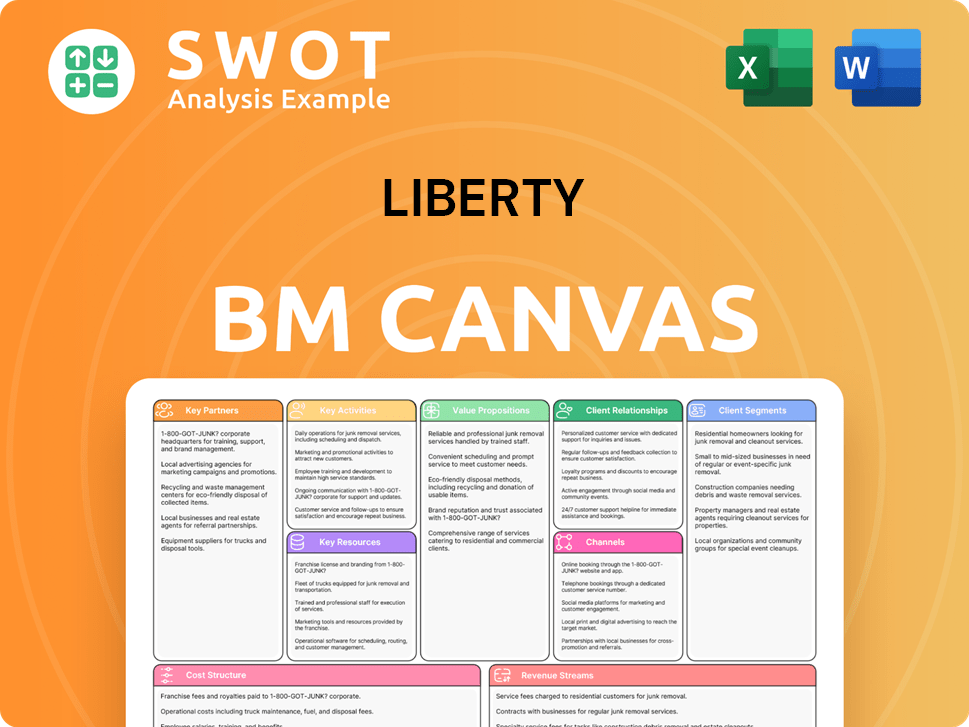
What Risks Could Slow Liberty’s Growth?
The Liberty Company faces several potential risks and obstacles as it pursues its growth strategy. These challenges span operational, regulatory, and market-related areas, potentially affecting its financial performance and strategic goals. Understanding these risks is crucial for investors and stakeholders evaluating the company's future prospects.
Market dynamics, technological disruptions, and regulatory changes present significant hurdles. The company must navigate fluctuating market conditions, adapt to evolving technologies, and comply with stringent environmental regulations. These factors can impact operational efficiency and profitability, requiring proactive strategic planning and business development initiatives.
The company's growth strategy must also consider supply chain vulnerabilities and the risks associated with its diversification into new markets. These factors, coupled with the need for continuous innovation, create a complex environment that demands careful risk management and strategic foresight.
The completions market faces intense competition and a potentially slowing demand environment. Industry activity saw declines since early 2023, with price pressures continuing into early 2025. These market dynamics could impact revenue and market share.
Regulatory changes, especially those concerning climate change and greenhouse gas (GHG) emissions, pose a significant risk. New regulations could lead to increased expenditures and potentially reduce demand for services, affecting profitability.
Supply chain issues and potential tariff impacts on equipment and supplies could increase costs. Operational hazards, such as mechanical problems and extreme weather, may disrupt operations and impact project timelines.
The company must maintain its leadership in innovation to avoid being disrupted by competitors. The shift towards electrification and advanced technologies in the oil and gas sector requires continuous investment to stay competitive and relevant.
Diversifying into the power generation market presents new challenges. This move exposes the company to unfamiliar operational and regulatory environments. Successful scaling and integration are crucial to avoid margin pressures.
Operational risks include mechanical problems, extreme weather, work stoppages, and labor strikes, which could disrupt operations. Reliance on rail transportation for proppant also creates vulnerability to delays.
To mitigate these risks, the company focuses on strategic diversification and maintaining a strong balance sheet. Investing in competitive advantages in both completions and power generation is crucial. The company's strategic planning must consider the evolving energy landscape, including the transition to renewable energy sources. This includes a detailed market analysis of the power generation sector.
The company emphasizes its scale, integrated services, and technology platform to outperform competitors. Continuous innovation and investment in advanced technologies are essential to maintain a competitive edge. This includes exploring new technologies and business models to enhance operational efficiency and reduce environmental impact.
Liberty Porter's Five Forces Analysis
- Covers All 5 Competitive Forces in Detail
- Structured for Consultants, Students, and Founders
- 100% Editable in Microsoft Word & Excel
- Instant Digital Download – Use Immediately
- Compatible with Mac & PC – Fully Unlocked
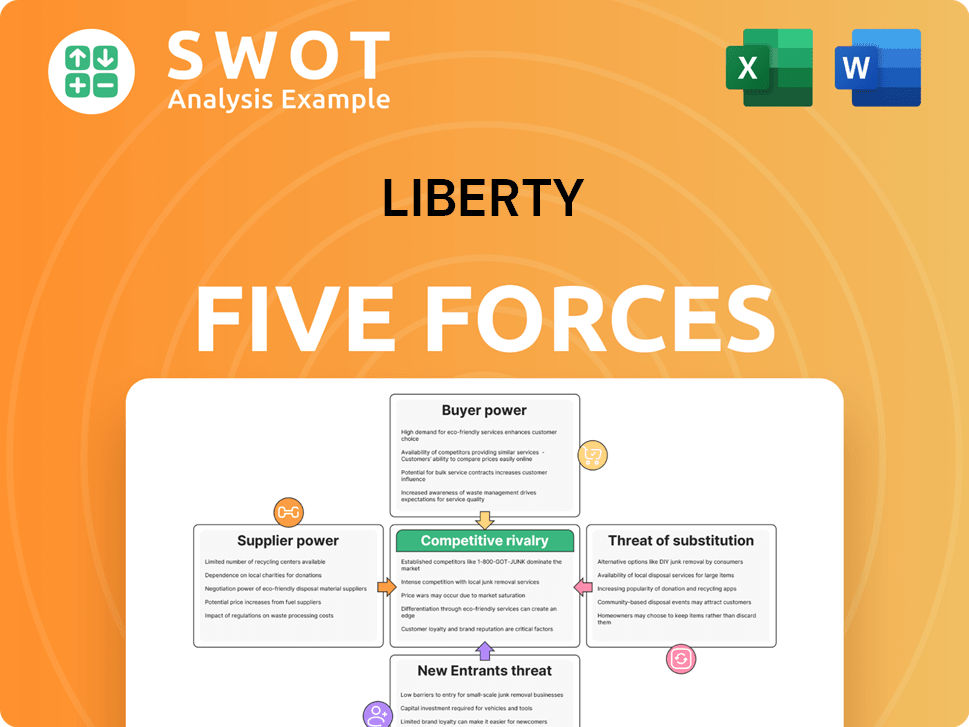
Related Blogs
- What are Mission Vision & Core Values of Liberty Company?
- What is Competitive Landscape of Liberty Company?
- How Does Liberty Company Work?
- What is Sales and Marketing Strategy of Liberty Company?
- What is Brief History of Liberty Company?
- Who Owns Liberty Company?
- What is Customer Demographics and Target Market of Liberty Company?
Disclaimer
All information, articles, and product details provided on this website are for general informational and educational purposes only. We do not claim any ownership over, nor do we intend to infringe upon, any trademarks, copyrights, logos, brand names, or other intellectual property mentioned or depicted on this site. Such intellectual property remains the property of its respective owners, and any references here are made solely for identification or informational purposes, without implying any affiliation, endorsement, or partnership.
We make no representations or warranties, express or implied, regarding the accuracy, completeness, or suitability of any content or products presented. Nothing on this website should be construed as legal, tax, investment, financial, medical, or other professional advice. In addition, no part of this site—including articles or product references—constitutes a solicitation, recommendation, endorsement, advertisement, or offer to buy or sell any securities, franchises, or other financial instruments, particularly in jurisdictions where such activity would be unlawful.
All content is of a general nature and may not address the specific circumstances of any individual or entity. It is not a substitute for professional advice or services. Any actions you take based on the information provided here are strictly at your own risk. You accept full responsibility for any decisions or outcomes arising from your use of this website and agree to release us from any liability in connection with your use of, or reliance upon, the content or products found herein.